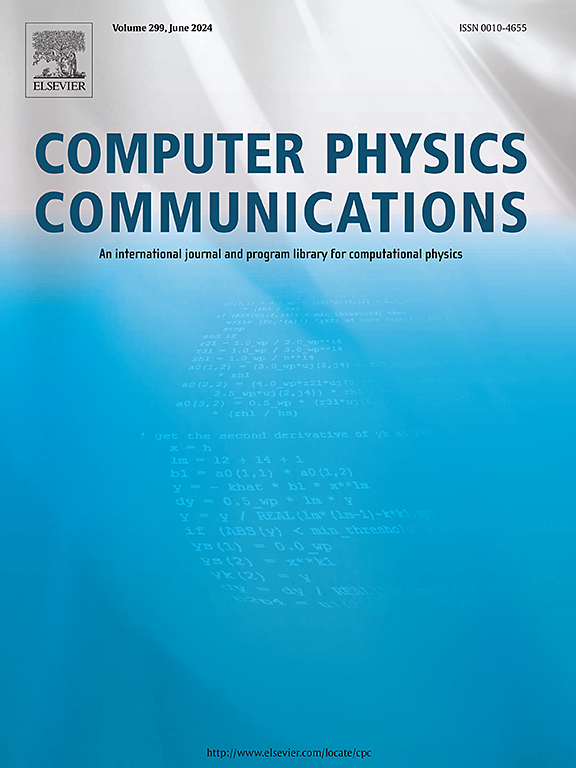A brief introduction to PACIAE 4.0
IF 7.2
2区 物理与天体物理
Q1 COMPUTER SCIENCE, INTERDISCIPLINARY APPLICATIONS
引用次数: 0
Abstract
Parton And-hadron China Institute of Atomic Energy (PACIAE) is a multipurpose Monte Carlo event generator developed to describe a wide range of high-energy collisions, including lepton-lepton, lepton-hadron, lepton-nucleus, hadron-hadron, hadron-nucleus, and nucleus-nucleus collisions. It is built based on the PYTHIA program, and incorporates parton and hadron cascades to address the nuclear medium effects. PACIAE 4.0 is the new generation of PACIAE model surpassing the version 3.0. In PACIAE 4.0, the old fixed-format FORTRAN 77 code has been refactored and rewritten by the free-format modern Fortran and C++ languages. The C++-based PYTHIA 8.3 is interfaced in, while previous versions connected to the Fortran-based PYTHIA 6.4 only. Several improvements are also introduced, which enable PACIAE 4.0 to contain more physics and features to model the high-energy collisions. This is the first attempt to transition PACIAE from Fortran to C++.
Program summary
Program Title: PACIAE 4.0
CPC Library link to program files: https://doi.org/10.17632/w3g68dj4d9.5
Developer's repository link: https://github.com/ArcsaberHep/PACIAE4
Licensing provisions: GPLv2 or later
Programming language: Fortran, C++
Journal reference of previous version: Computer Physics Communications 284 (2023) 108615
Does the new version supersede the previous version?: Yes
Reasons for the new version: Improved and expanded physics models, transition from FORTRAN 77 to the modern Fortran mixed with C++
Summary of revisions: PYTHIA 8 interface, transition to modern Fortran mixed with C++, and much more.
Nature of problem: The Monte Carlo (MC) simulation has been successfully applied to the study of the high-energy collisions. MC models are able to give a fairly good description of the basic experimental observables. However, as more and more experimental data become available, more accurate modeling is required.
Solution method: The parton and hadron cascade model PACIAE 2 series [1-6] and 3.0 [7] are based on the Fortran-based PYTHIA 6.4 [8]. PYTHIA has been upgraded to the C++-based PYTHIA 8.3 [9] with more physics and features. Therefore we upgrade the PACIAE model to the new version of PACIAE 4.0 with the option to either PYTHIA 6.4 [8] or PYTHIA 8.3 [9]. In addition, several improvements have been introduced in this new version.
Additional comments including restrictions and unusual features: Restrictions depend on the problem studied. The running time is 1–1000 events per minute, depending on the collisions system studied.
References
- [1]B.-H. Sa, et al., Comput. Phys. Commun. 183 (2012) 333.
- [2]B.-H. Sa, et al., Comput. Phys. Commun. 184 (2013) 1476.
- [3]D.-M. Zhou, et al., Comput. Phys. Commun. 193 (2015) 89.
- [4]Y.-L. Yan, et al., Comput. Phys. Commun. 224 (2018) 417.
- [5]Z.-L. She, et al., Comput. Phys. Commun. 274 (2022) 108289.
- [6]Y.-L. Yan, et al., Comput. Phys. Commun. 284 (2023) 108615.
- [7]A.-K. Lei, et al., Phys. Rev. C 108 (2023) 064909.
- [8]T. Sjöstrand, et al., J. High Energy Phys. 05 (2006) 026.
- [9]C. Bierlich, et al., SciPost Phys. Codeb. 8 (2022).
PACIAE 4.0的简要介绍
中国原子能研究所(PACIAE)是一个多用途蒙特卡罗事件发生器,用于描述各种高能碰撞,包括轻子-轻子、轻子-强子、轻子-核、强子-强子、强子-核和核-核碰撞。它是在PYTHIA程序的基础上建立的,并结合了部分子和强子级联来解决核介质效应。PACIAE 4.0是超越3.0版本的新一代PACIAE模型。在PACIAE 4.0中,旧的固定格式FORTRAN 77代码已经被自由格式的现代FORTRAN和c++语言重构和重写。基于c++的PYTHIA 8.3是接口,而以前的版本只连接到基于fortran的PYTHIA 6.4。还介绍了几项改进,使PACIAE 4.0包含更多的物理和特性来模拟高能碰撞。这是将PACIAE从Fortran过渡到c++的第一次尝试。程序摘要程序标题:PACIAE 4.0CPC库链接到程序文件:https://doi.org/10.17632/w3g68dj4d9.5Developer's存储库链接:https://github.com/ArcsaberHep/PACIAE4Licensing条款:GPLv2或更高编程语言:Fortran, c++期刊参考以前的版本:计算机物理通信284(2023)108615新版本是否取代以前的版本?新版本的原因:改进和扩展了物理模型,从FORTRAN 77过渡到与c++混合的现代FORTRAN,修订摘要:PYTHIA 8接口,过渡到与c++混合的现代FORTRAN,以及更多。问题性质:蒙特卡罗模拟已成功地应用于高能碰撞的研究。MC模型能够很好地描述基本的实验观测值。然而,随着实验数据的增多,需要更精确的建模。求解方法:parton -强子级联模型PACIAE 2系列[1-6]和3.0[7]是基于fortran的PYTHIA 6.4[8]。PYTHIA已经升级到基于c++的PYTHIA 8.3[9],具有更多的物理和功能。因此,我们将PACIAE模型升级到新版本的PACIAE 4.0,并可选择PYTHIA 6.4[8]或PYTHIA 8.3[9]。此外,在这个新版本中还引入了一些改进。附加注释包括限制和不寻常的功能:限制取决于所研究的问题。运行时间为每分钟1 - 1000个事件,具体取决于所研究的碰撞系统。Sa等人,计算。理论物理。公共。183 (2012)333. b[2] b - h。Sa等人,计算。理论物理。[j] .社会科学,2014(5):391 - 391。周,等,计算。理论物理。公报。193(2015)89。Yan等人,计算。理论物理。[j] .中国农业科学,2016,(5):417.]她等人,计算。理论物理。公共科学。274 (2022)108289.[6]y - l。Yan等人,计算。理论物理。公共。284 (2023)108615.[7]a - k。雷等人,物理学。Rev. C 108(2023) 064909.[8]。Sjöstrand,等。高能物理。05(2006)026.[9]。Bierlich等人,《科学邮报物理》。Codeb. 8(2022)。
本文章由计算机程序翻译,如有差异,请以英文原文为准。
求助全文
约1分钟内获得全文
求助全文
来源期刊

Computer Physics Communications
物理-计算机:跨学科应用
CiteScore
12.10
自引率
3.20%
发文量
287
审稿时长
5.3 months
期刊介绍:
The focus of CPC is on contemporary computational methods and techniques and their implementation, the effectiveness of which will normally be evidenced by the author(s) within the context of a substantive problem in physics. Within this setting CPC publishes two types of paper.
Computer Programs in Physics (CPiP)
These papers describe significant computer programs to be archived in the CPC Program Library which is held in the Mendeley Data repository. The submitted software must be covered by an approved open source licence. Papers and associated computer programs that address a problem of contemporary interest in physics that cannot be solved by current software are particularly encouraged.
Computational Physics Papers (CP)
These are research papers in, but are not limited to, the following themes across computational physics and related disciplines.
mathematical and numerical methods and algorithms;
computational models including those associated with the design, control and analysis of experiments; and
algebraic computation.
Each will normally include software implementation and performance details. The software implementation should, ideally, be available via GitHub, Zenodo or an institutional repository.In addition, research papers on the impact of advanced computer architecture and special purpose computers on computing in the physical sciences and software topics related to, and of importance in, the physical sciences may be considered.
 求助内容:
求助内容: 应助结果提醒方式:
应助结果提醒方式:


